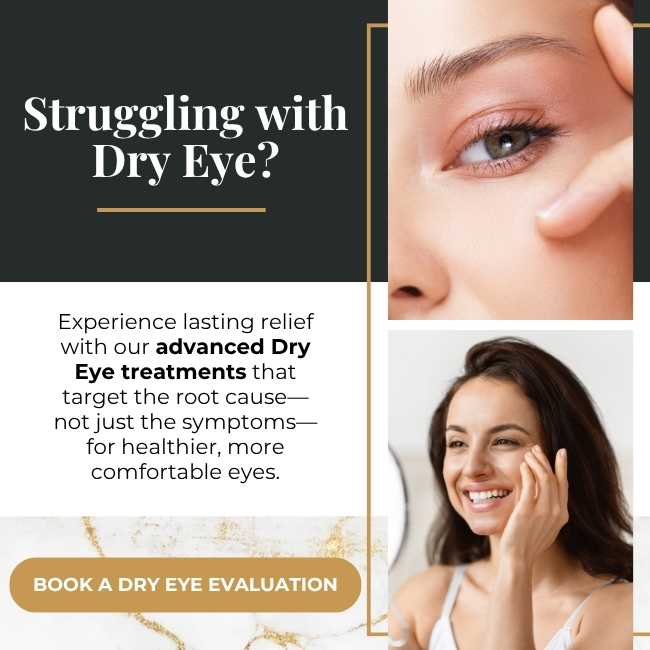Have you noticed your vision becoming slightly blurred, especially after long periods in front of a computer screen?
Perhaps surprisingly, dry eyes might be the culprit behind your discomfort. The link between dry eyes and blurry vision lies in the important role the tear film plays in ensuring clear vision.
Dry eyes disrupt the tear film, which is the first layer light encounters as it’s entering your eyes. If this layer is uneven and not perfectly smooth, which is the case with dry eyes, you will experience distorted and blurred vision. If you’re experiencing this issue, it’s time to consider scheduling an eye exam with your optometrist or dry eye specialist.
What Causes Dry Eyes?
Dry eyes occur when your tears can’t provide adequate lubrication for your eyes. This can happen for several reasons:
- Decreased tear production as you age
- Imbalance in the composition of your tears
- Spending long hours in front of screens
- Spending too much time in air-conditioned or heated rooms
- Exposure to wind and smoke
- Contact lenses
- Use of antihistamines, decongestants, and even some blood pressure medications
- Underlying medical conditions such as diabetes, rheumatoid arthritis, or thyroid disorders
How Dry Eyes Affect Your Vision
The direct connection between dry eyes and blurry vision lies in the tear film, which is composed of 3 layers:
- Oil
- Water
- Mucus
Each layer plays a critical role. The oil layer prevents evaporation, the water layer nourishes and hydrates, and the mucus layer ensures even distribution across the eye.
If one or more of these layers isn’t functioning correctly, the tear film becomes unstable. The absence of a stable tear film causes light to be scattered through the eye rather than being focused correctly. This results in vision that can appear blurry or distorted.
Some people may find that their eyes feel tired, making it hard to concentrate on tasks like reading or using a computer.
Fluctuating vision quality is another common symptom of dry eyes, where your sight might be sharp one moment and blurry the next. This can particularly be the case after prolonged periods of screen time or reading.
Other Common Symptoms of Dry Eyes
While blurry vision is a notable symptom, dry eyes come with a variety of other signs. If you’re experiencing any of these, it might be worth considering whether dry eyes are to blame:
- Redness: Often, dry eyes can become inflamed, resulting in a noticeable redness.
- Stinging or Burning: Many describe their eyes as feeling like they’re on fire, particularly in dry or windy environments.
- The feeling of Grittiness: Some people report a sensation as if something is stuck in their eyes.
- Sensitivity to Light: Bright lights may become uncomfortable and exacerbate the dryness.
- Watery or Tearing: Eyes are over-compensating for dryness by reflexing tearing.
- Tired Eyes: Your eyes might feel strained after short periods of activity, like reading or watching TV.
Treatment Options for Dry Eyes
Fortunately, there are several effective treatment options for managing dry eyes.
- Radiofrequency treatment by InMode Forma helps stimulate the eyelid glands to produce the oil layer and improve tear retention in the eyes.
- Intense Pulsed Light (IPL) Therapy by InMode Lumecca is another option that targets inflammation which is the driving force of dry eyes. Inflamed eyes are dry, irritated eyes!
- Meibomian Gland Expression will unclog eyelid glands responsible for oil production that prevents tear evaporation.
- Eyelid exfoliation involves gentle plaque removal of bacteria, mites and debris buildup to promote healthier eyelid margins and decrease further eyelid gland clogging.
- Punctal plugs are small devices inserted into the tear ducts to block tear drainage and maximize the tears you are naturally producing.
It’s important to consult with your optometrist to determine the best treatment plan that is tailored to your specific needs.
Preventing Blurry Vision Caused by Dry Eyes
Prevention is a key component in managing dry eyes and preventing blurry vision.
- Start by modifying your environment. Ensure your workspace is adequately humidified, and consider using a humidifier in your home, especially during winter months.
- If you work at a computer, take regular breaks using the 20-20-20 rule—every 20 minutes, look at something 20 feet away for at least 20 seconds.
- Staying hydrated is also crucial; make sure to drink plenty of water throughout the day.
- Adjust your diet to include omega-3 fatty acids, found in fish like salmon and flaxseeds, as they can improve oil production in your tear film, reducing evaporation.
When to See an Eye Doctor
It’s never too early to have an assessment of signs of dry eyes and to discuss dry eye prevention. An optometrist specializing in dry eyes can provide a thorough examination to identify the underlying cause of your symptoms before you lose the ability to produce healthy tears to lubricate your eyes for many many years to come.
Regular eye exams can also catch potential complications early, ensuring your vision remains clear and healthy.
Need Help with Dry Eyes?
Dry eyes may seem like a minor inconvenience at first, but they can significantly impact your vision, comfort, and daily life. Left untreated, dry eyes will progress into a painful dry eye disease condition which can require a lifetime of medicated eye drops.
From lifestyle changes to professional treatments, there are options to treat dry eyes and the discomfort that comes with it. Although there is no CURE for dry eyes, there are treatments and prevention strategies. Remember, your eyes are precious, and taking steps to care for them today ensures they serve you well into the future.Want to book an appointment with Luminance Vision’s dry eye specialist eye doctors for personalized advice and guidance? We look forward to helping your eyes look and feel their best!




